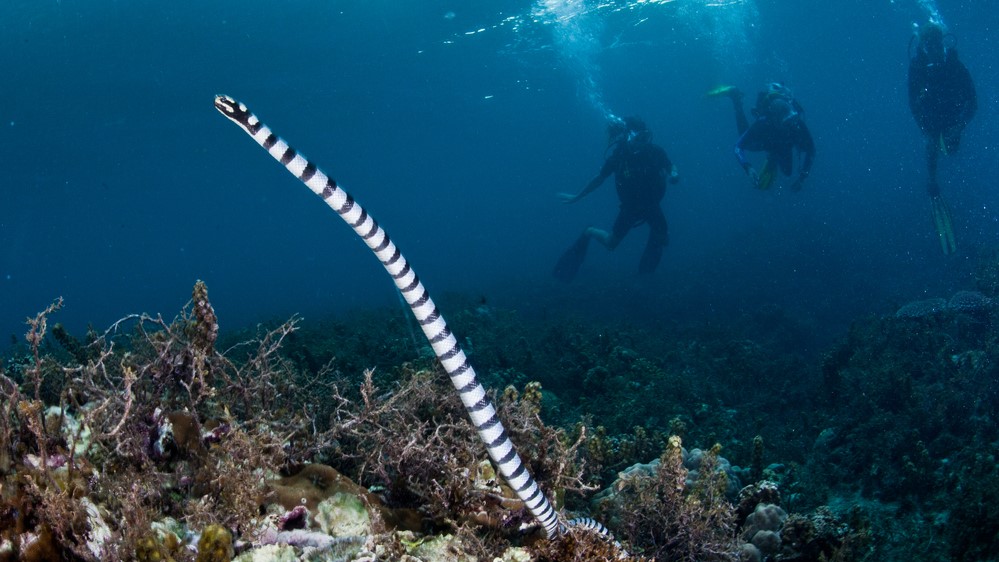Sexually frustrated sea snakes mistake scuba divers for potential mates
The snakes' poor vision is believed to be behind the confusion.
A scuba diver off Australia noticed some odd behavior whenever he came into contact with male sea snakes: The venomous reptiles would coil around his fins, licking the water around him and even sometimes chasing him underwater. Now, he knows why: It was mating season, and the males thought he was a potential mate.
In a new study, the diver and another researcher analyzed 158 of these interactions with olive sea snakes (Aipysurus laevis) over several years in the Great Barrier Reef and found that interactions were more common during the reptiles' mating season. The sexually frustrated snakes also displayed elaborate behaviors that are often used during courtship between the sea serpents.
"Males are very aroused and active while looking for 'girlfriends,'" lead author Rick Shine, an evolutionary biologist and reptile expert at Macquarie University in Australia, told Live Science. But because the males can't tell the difference between female snakes and scuba divers, it can lead to some comical interactions, he added.
Related: 7 shocking snake stories
Although olive sea snakes are venomous, and potentially lethal, to humans, the researchers do not think believe that people are at an increased risk from swimming with the reptiles during their mating season.
Close encounters
Tim Lynch — now a senior research scientist at CSIRO, Australia's national science agency — collected the data while working on his doctorate at James Cook University in Australia in the mid-1990s. He recorded the encounters around the Keppel Islands in the southern Great Barrier Reef and was the first to notice a link between their unusual behavior and mating.
"It was exciting; they are the most graceful of animals and also have no evolutionary relationship with people," Lynch said. "They are not actually trying to attack you; they are just curious."
Get the world’s most fascinating discoveries delivered straight to your inbox.
The new study came about after Shine read Lynch's work while researching sea snakes. "I read his thesis, thought it was great and convinced him to collaborate with me to finally publish these exciting results," Shine said.
Although the data were collected more than 25 years ago, the researchers still think the findings are relevant today.
"I think the data is still sound, as the behaviors of the snakes, and probably people as well, will not have changed," Lynch said.
Sexually motivated
During 74 out of 158 encounters, Lynch was approached by a sea snake, and a majority of these overlapped with their mating season, between May and August. Males were also significantly more likely than females to approach, and display some mating behaviors toward, the diver, especially during the mating season.
Lynch also described behaviors known to occur during the mating season, such as males coiling their bodies around his fins.
"Males coil around females during courtship, probably to hang on effectively while they get into position to mate," Shine said.
The males also tended to flick out their tongues at Lynch. However, the most striking behavior occurred in 13 incidents, when the males rapidly chased Lynch underwater when he swam away.
"Females don't do any chasing; they do the fleeing [during mating]," Lynch said. "So swimming away from a male snake is mimicking courtship behavior," which encourages the male to follow.
The researchers suspect that the snakes that chased Lynch were probably in the midst of a failed mating attempt.
"It's clear that most approaches to divers were by males who had lost contact with the females they were pursuing," Shine said. "They frantically search for a female if they lose touch with her."
Mistaken identity
The researchers suspect that sea snakes cannot properly distinguish between shapes underwater.
"It's a lot more difficult to see through water than through air, especially if the water is rough or dirty," Shine said. Sea snakes also evolved from land snakes fairly recently, so they don't have a visual system that works well underwater, he added.
Instead, sea snakes rely more on scent and less on vision to experience their world.
That is likely why tongue flicking was such a commonly observed behavior during interactions with divers, Lynch said. "They can only really confirm that you are not a female snake by licking you."
Sea snake tongues pick up chemicals in the water that then get analyzed by a special gland in the roof of the mouth, Shine said. This means that a sea snake has to get very close to an object to identify it, he added.
Misunderstood behavior
Divers don't need to worry about being attacked while swimming with these sea snakes.
"Very few recreational users of the ocean are bitten by sea snakes, so the danger is low," Shine said. "Most bites, including fatal ones, are to fishers who haul snakes out of the water."
For instance, in the most recently reported human death from a sea snake bite, a British man was killed when he was handling a black ringed sea krait (Laticauda semifasciata) that was caught in a net byf a fishing trawler off the north coast of Australia in 2018, according to the BBC.
Lynch was bitten several times during his doctoral work. However, these instances involved him physically handling the snakes, and he was always wearing wet-suit gloves. "Olive sea snakes do not usually bite unless harassed underwater," Lynch said, "but they are enthusiastic biters when brought onto land."
Although people should always remain cautious around venomous animals, the researchers see no reason people should avoid sea snakes completely. "If you know what is going on you can relax, settle onto the bottom and stay still and let the snakes investigate you," Lynch said.
The study was published online Aug. 19 in the journal Scientific Reports.
Originally published on Live Science.

Harry is a U.K.-based senior staff writer at Live Science. He studied marine biology at the University of Exeter before training to become a journalist. He covers a wide range of topics including space exploration, planetary science, space weather, climate change, animal behavior and paleontology. His recent work on the solar maximum won "best space submission" at the 2024 Aerospace Media Awards and was shortlisted in the "top scoop" category at the NCTJ Awards for Excellence in 2023. He also writes Live Science's weekly Earth from space series.




